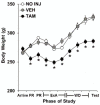Tamoxifen Blocks the Development of Motivational Features of an Addiction-Like Phenotype in Female Rats
- PMID: 31780909
- PMCID: PMC6856674
- DOI: 10.3389/fnbeh.2019.00253
Tamoxifen Blocks the Development of Motivational Features of an Addiction-Like Phenotype in Female Rats
Abstract
Women become addicted sooner after initiating cocaine use as compared to men. Preclinical studies reveal a similar vulnerability in females, with findings from ovariectomized rats suggesting that estradiol mediates the enhanced vulnerability. However, since ovariectomy depletes not only estradiol, but all ovarian hormones, its role in a physiological context is not clear. Thus, the goal of this study was to determine the role of estradiol in the development of an addiction-like phenotype in ovary-intact females treated chronically with the selective estrogen receptor (ER) modulator tamoxifen. We hypothesized that tamoxifen, by antagonizing ERs, would block the development of an addiction-like phenotype as defined by an enhanced motivation for cocaine (assessed under a progressive-ratio schedule), and a heightened vulnerability to relapse (assessed under an extinction/cue-induced reinstatement procedure). Effects were examined following extended access cocaine self-administration (24-h/day; 4-discrete trials/h; 1.5 mg/kg/infusion) and 14-days of abstinence, conditions optimized for inducing an addiction-like phenotype. As predicted, motivation for cocaine was increased following extended-access self-administration and protracted abstinence in the vehicle (sesame oil) and no-injection control groups, but not in the tamoxifen group indicating that ER signaling is critical for the development of this feature of an addiction-like phenotype. Surprisingly, the increase in motivation for cocaine following abstinence was also attenuated in the vehicle group as compared to no-injection controls suggesting that oil/injections also affected its development. Contrary to our hypothesis, tamoxifen did not decrease vulnerability to relapse as this group responded at similar levels during initial extinction sessions and cue-induced reinstatement testing as compared to controls. Tamoxifen did, however, impair extinction learning as this group took longer to extinguish as compared to controls. Taken together, these findings indicate that estradiol is critical for the extinction of drug-associated cues and the development of motivational features of addiction.
Keywords: cocaine; estradiol; extended access; self-administration; sex differences.
Copyright © 2019 Bakhti-Suroosh, Nesil and Lynch.
Figures





Similar articles
-
Estradiol as a mechanism for sex differences in the development of an addicted phenotype following extended access cocaine self-administration.Neuropsychopharmacology. 2013 Aug;38(9):1698-705. doi: 10.1038/npp.2013.68. Epub 2013 Mar 12. Neuropsychopharmacology. 2013. PMID: 23481437 Free PMC article.
-
Estradiol Enhances the Development of Addiction-Like Features in a Female Rat Model of Opioid Use Disorder.Neuroendocrinology. 2023;113(11):1099-1111. doi: 10.1159/000529997. Epub 2023 Mar 6. Neuroendocrinology. 2023. PMID: 36878201 Free PMC article.
-
Decreased motivation following cocaine self-administration under extended access conditions: effects of sex and ovarian hormones.Neuropsychopharmacology. 2005 May;30(5):927-35. doi: 10.1038/sj.npp.1300656. Neuropsychopharmacology. 2005. PMID: 15647749
-
Modeling the development of drug addiction in male and female animals.Pharmacol Biochem Behav. 2018 Jan;164:50-61. doi: 10.1016/j.pbb.2017.06.006. Epub 2017 Jun 15. Pharmacol Biochem Behav. 2018. PMID: 28624586 Free PMC article. Review.
-
Sex Differences and the Role of Estradiol in Mesolimbic Reward Circuits and Vulnerability to Cocaine and Opiate Addiction.Front Behav Neurosci. 2020 May 20;14:74. doi: 10.3389/fnbeh.2020.00074. eCollection 2020. Front Behav Neurosci. 2020. PMID: 32508605 Free PMC article. Review.
Cited by
-
Role of nucleus accumbens dopamine 2 receptors in motivating cocaine use in male and female rats prior to and following the development of an addiction-like phenotype.Front Pharmacol. 2023 Jul 26;14:1237990. doi: 10.3389/fphar.2023.1237990. eCollection 2023. Front Pharmacol. 2023. PMID: 37564182 Free PMC article.
-
Effects of Sex and Estrous Cycle on the Time Course of Incubation of Cue-Induced Craving following Extended-Access Cocaine Self-Administration.eNeuro. 2021 Aug 11;8(4):ENEURO.0054-21.2021. doi: 10.1523/ENEURO.0054-21.2021. Print 2021 Jul-Aug. eNeuro. 2021. PMID: 34290059 Free PMC article.
-
Sex/Gender Differences in the Time-Course for the Development of Substance Use Disorder: A Focus on the Telescoping Effect.Pharmacol Rev. 2023 Mar;75(2):217-249. doi: 10.1124/pharmrev.121.000361. Epub 2022 Dec 12. Pharmacol Rev. 2023. PMID: 36781217 Free PMC article. Review.
-
Females develop features of an addiction-like phenotype sooner during withdrawal than males.Psychopharmacology (Berl). 2021 Aug;238(8):2213-2224. doi: 10.1007/s00213-021-05846-3. Epub 2021 Apr 27. Psychopharmacology (Berl). 2021. PMID: 33907871 Free PMC article.
-
Sex differences in the neuroadaptations associated with incubated cocaine-craving: A focus on the dorsomedial prefrontal cortex.Front Behav Neurosci. 2023 Jan 5;16:1027310. doi: 10.3389/fnbeh.2022.1027310. eCollection 2022. Front Behav Neurosci. 2023. PMID: 36688133 Free PMC article.
References
LinkOut - more resources
Full Text Sources
Research Materials

